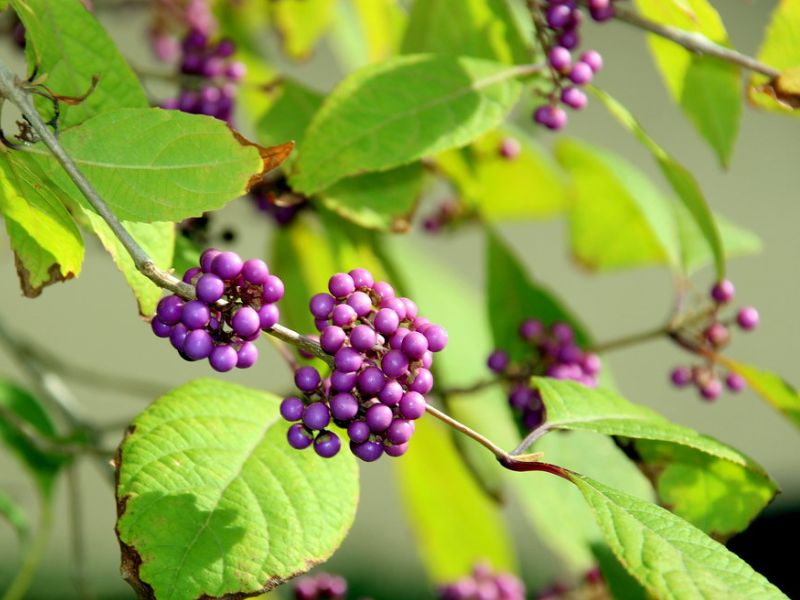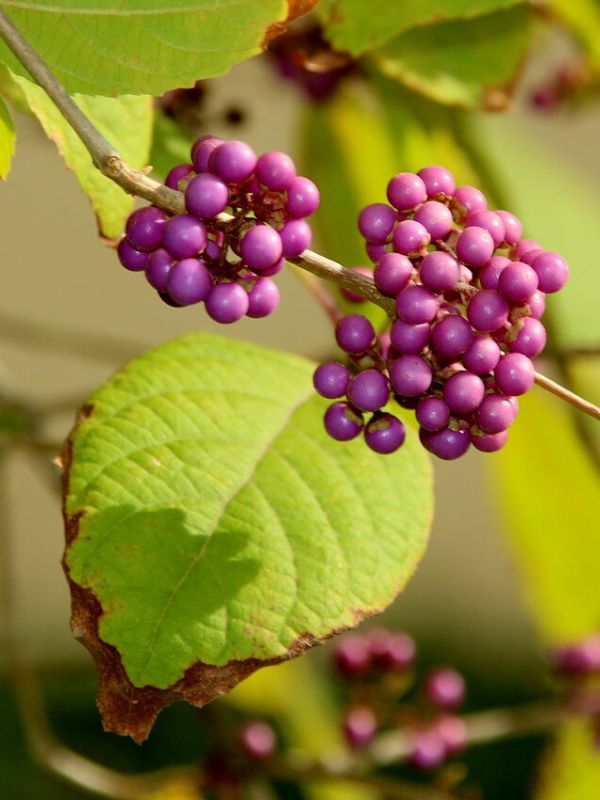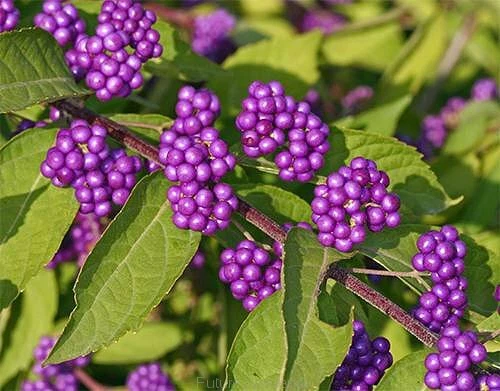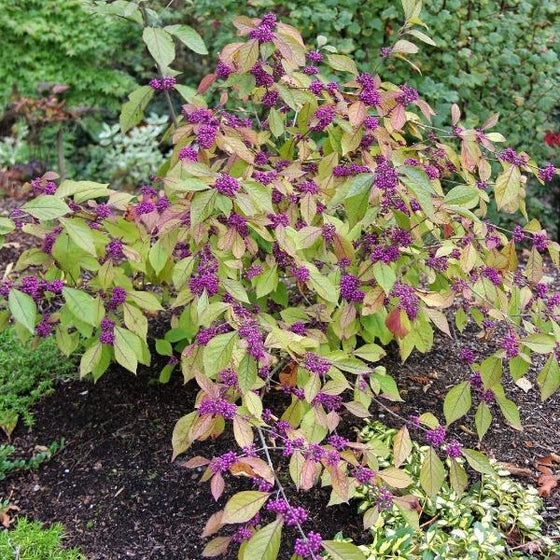Bodinier Beautyberry, also known as Profusion Beautyberry, is a perennial shrub scientifically named Callicarpa bodinieri. Belonging to the Lamiaceae family, this species originates from Southern China to Indo-China and is celebrated for its vibrant clusters of purple berries that brighten up gardens even as the colder months set in.
Renowned for its cold-hardiness, Bodinier Beautyberry retains its striking berries on bare branches into early winter, making it a standout feature in any landscape. The plant is named after Emile Maire Bodinier, a French missionary and botanist who introduced it to the western world. Over two centuries of cultivation have led to the development of several award-winning cultivars, enhancing its popularity among gardeners worldwide.
| Common name | Bodinier Beautyberry, Profusion Beautyberry |
| Botanical name | Callicarpa bodinieri |
| Family | Lamiaceae |
| Species | bodinieri |
| Origin | Southern China to Indo-China |
| Life cycle | Perennial |
| Plant type | Perennial |
| Hardiness zone | 5, 6, 7, 8 |
| Sunlight | Full Sun |
| Maintenance | Low |
| Soil condition | Clay |
| Soil ph | Acid |
| Drainage | Well-Drained |
| Growth rate | Medium |
| Spacing | 6 – ft. – 12 ft. |
| Harvest time | Fall |
| Flowering period | Spring |
| Height | 6 ft. – 10 ft. |
| Flower color | Blue |
| Leaf color | Gold, Yellow |
| Fruit color | Blue |
| Fruit type | Berry |
| Fruit benefit | Long-lasting |
| Garden style | Butterfly Garden |
| Uses | Meadow |
I. Appearance and Characteristics
Callicarpa bodinieri, or Bodinier’s beautyberry, is a species of flowering plant in the genus Callicarpa of the family Lamiaceae, native to West and Central China. Growing to 3 m (10 ft) tall by 2.5 m (8 ft) wide, it is an upright deciduous shrub with dark green leaves turning red in autumn (fall). In midsummer, small lilac flowers are produced in the leaf axils. But it is grown in gardens primarily for its small, decorative purple berries in tight clusters in autumn.

The Latin specific epithet bodinieri refers to Émile-Marie Bodinier, a French missionary and botanist of the 19th century, who collected plants in China.
The cultivar C. bodinieri var. giraldii ‘Profusion’ has gained the Royal Horticultural Society’s Award of Garden Merit.
II. How to Grow and Care
Sunlight
Bodinier’s beautyberry thrives in full sun, as optimal exposure to light enhances its growth and promotes the vibrant coloration of its signature berries. These conditions typically involve direct sunlight for at least six hours a day. While bodinier’s beautyberry shows a high level of adaptability and can tolerate partial sun, reduced light may result in a less robust flowering and fruiting display, and a potential decrease in foliage density.
Outdoors, bodinier’s beautyberry should be planted in a position that receives ample sunlight, while avoiding locations that are too shaded. Adaptable to various outdoor environments, this plant adjusts well to the light available, although its ornamental qualities are most pronounced under ideal light conditions.
Temperature
Bodinier’s beautyberry likes warm environments with a temperature of 25 to 28 ℃, but can also grow at higher temperatures up to 35 ℃. However, it is not cold-hardy and generally suffers in low temperatures around -10 ℃. Because the plant can easily die in low temperatures, it should be planted in pots and moved indoors during winter.

Bodinier’s beautyberry prefers moist environments. It is slightly tolerant of drought but not waterlogging. However, during summer flowering periods and fall fruiting periods, bodinier’s beautyberry needs more water, so it is best to keep the soil moist.
Watering
Originating from regions with distinct wet and dry seasons, bodinier’s beautyberry has adapted to periods of lower moisture availability, showcasing moderate drought tolerance. Its water habits are balanced, requiring a steady but not excessive supply of moisture to thrive.
Watering for bodinier’s beautyberry should be done once every 1-2 weeks, ensuring soil hydration without oversaturation. As an outdoor plant often cultivated for its ornamental berries, bodinier’s beautyberry benefits from mulching to retain soil moisture during its active growing season.
Soil
Fertile, well-drained, sandy soil is the best choice for growing bodinier’s beautyberry. Ideally the soil is deep (more than 50 cm thick) and has few weeds. Bodinier’s beautyberry grows best in pH 5.5-7.5, slightly acidic to neutral soil. The plant can also survive on the edge of slopes or swamps. When given sufficient nutrients, it will grow and flower quickly. If soil nutrients are insufficient, add nutrient soil or organic fertilizer to improve it.
Fertilizing
To optimize bodinier’s beautyberry’s thriving, apply balanced fertilizers (like 10-10-10) in spring to support foliage and flower development. During active growth, enriching the soil with high-nitrogen formulas will enhance leafy growth and berry abundance; however, this is less critical outside the growth period.

Annually adjust quantities for bodinier’s beautyberry’s size; a handful suffices for young plants, whereas mature ones may need more. Fertilize bodinier’s beautyberry sparingly to avoid overstimulation, which can lead to fewer flowers and berries. Always water bodinier’s beautyberry after applying fertilizer to aid absorption. Monitor growth signals and season changes to tailor bodinier’s beautyberry’s feeding schedule for sustained health and beauty.
Pruning
In spring and summer, remove overgrown branches regularly to keep the interior of the plant well-ventilated. If any branches grow too long and affect the overall plant shape, cut them short promptly. In late winter when bodinier’s beautyberry fruits fall or shrivel, cut off most of the current year’s branches, leaving only 1-2 nodes. This is conducive to annual flowering and fruiting.
For bodinier’s beautyberry that is propagated by cutting, cut off any branches over 10 cm from the ground in late fall to promote the growth of more branches the following year. Each plant can retain 3-5 major branches that grow in different directions.
Propagation

Bodinier’s beautyberry is usually propagated by cutting. Early spring is the best time for cutting, but summer is acceptable as well. Choose a robust, brown branch of 6 mm or more in thickness that is 1-3 years old and cut about 15 cm from the base to the middle (2-3 nodes).
After soaking the base of the branch with rooting powder, drill holes vertically in sterilized soil with a thin wooden stick to prevent the branch epidermis from rubbing directly against the soil. Repeat for each branch, then insert the branches into the holes and bury nearly 2/3 of them in the soil. Space branches about 8 cm apart. In summer, shade seedlings with a net. Keep the soil moist and free of standing water.
Transplanting
The optimal time for shifting bodinier’s beautyberry is between late S1 and early S2; during these periods, the weather is best-suited for its roots to settle. Bodinier’s beautyberry thrives in fertile well-drained soil, in both sunlight exposure and shaded areas. Always water thoroughly after relocating!
III. Harvesting and Storage
You can harvest bodinier’s beautyberry flowers for decoration. Harvest in the morning when the temperature is low. Choose flowers that are not fully open and cut off the base of the branch at an angle with garden scissors. Insert the flowers into freshwater as soon as possible to prevent them from losing water.

In the fall, you can also cut off branches that hold a lot of fruits and put them in an empty jar for decoration. Some birds eat bodinier’s beautyberry fruits, but the fruits taste very bad and are not suitable for humans to eat. If you crush its leaves, the plant releases aromatic oil that has some mosquito-repellent properties. This oil is not recommended for application on children, though.
Find Where to Buy the Best Profusion Beautyberry (Callicarpa bodinieri)


















Leave a Reply